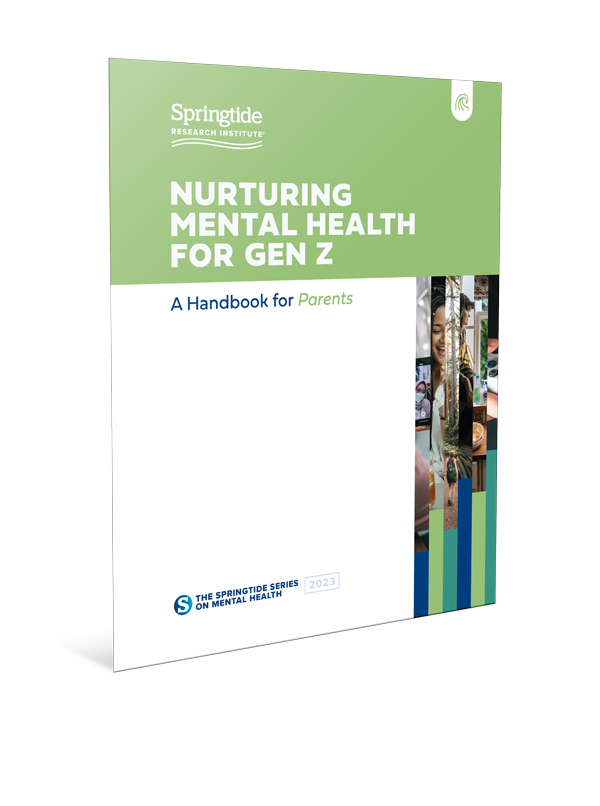
Ensuring Mental Wellness for Transgender and Nonbinary Youth
At Springtide we are committed to the flourishing and wellness of all young people. Our data show that, in some instances, young people with diverse sexual and gender identities have relational experiences that can be harmful to their mental, emotional and spiritual health — and in turn they need specific kinds of support to thrive. As a research institute, we lean on practitioners who serve young people directly to guide adults in how to best support young people. In this post, taken from Nurturing Mental Health for Gen Z: A Handbook for Parents, former PFLAG National Director of Learning & Inclusion Jean-Marie Navetta shares how parents can support the mental health of transgender and nonbinary youth.
Let’s start with this fact: Parenting isn’t easy.
A strong argument can be made that parenting in the current social landscape is tougher than ever. The immediacy and power of social media are overwhelming. The challenges youth face today are far different from when their parents were young. And, regardless of identity or politics, the hostile climate created by political strife has been more invasive and divisive than ever before. Often, it feels like it will take far more than love (or even a village) to raise a thriving child.
For parents and caregivers of transgender and nonbinary youth, this is especially true. Witnessing attacks on the transgender and nonbinary community, observing biases against trans and nonbinary people, and grappling with one’s own learning and acceptance curve often make parenting healthy trans and nonbinary youth feel like an unwinnable battle.
But it is a battle we cannot afford to ignore. Springtide found that 60% of nonbinary youth and 62% of transgender youth do not identify their homes as “safe havens.” Worse, many nonbinary and transgender youth do not feel a sense of belonging in their own family, with 50% of nonbinary youth and 51% of transgender youth disagreeing with the statement “I feel like I belong in my family.” To change these sentiments and associated negative outcomes, parents need to lean into “giving grace”—acknowledging that we all want to do what is best for one another, but in the process, we don’t always get it right. Grace comes in when we talk about these mistakes and use what we learn to inform what happens next. This must be part of
the framework for parents and youth that’s actively used in this journey—an agreement that the effort won’t be perfect, but finding solutions together is how we create safety and belonging.
Parents can do this in three key ways: creating safe spaces at home, protecting kids at school, and making mental health a family priority.
Create safe spaces at home.
The fact that roughly half of transgender and nonbinary youth say they don’t feel like they belong in their families is a call to action. If youth don’t feel safe at home, there are reasons why, and they might be hard for parents to hear. Nonetheless, parents should initiate these discussions and talk about why young people may not feel safe addressing issues with them. Ask questions of young people to demonstrate your need to understand (e.g., “What was it that I said or did that made you feel that way? How could that have been different?”). It needs to be a family discussion, where parents or caregivers and siblings are part of the ongoing conversation. Family members should be empowered to interrupt the moment when things aren’t going well and collectively work to center around respect and belonging. And if some family members choose not to provide support and acceptance, it becomes the responsibility of those who are affirming to boost their efforts to create safe spaces and address remarks and behaviors that are unacceptable.
Protect kids at school.
Springtide data show that school can be a challenging place for transgender and nonbinary youth. Navigating school dynamics and interpersonal relationships, as well as witnessing attempts to restrict their school experience based on how they identify, takes an emotional toll. Parents can’t fix everything, but they can affect important changes in the school experience. Find out what’s available to ensure equity in schools (e.g., Gender and Sexuality Alliances, inclusive bullying and harassment policies, procedures for addressing complaints). If programming or support isn’t available, ask why and how you can help change things. Show up for school board meetings and offer input into the decisions being made. Ask youth what is happening, and don’t write bullying off as a harmless rite of passage. When a solution needs to be developed to address an issue, work with youth to develop a plan of action. Springtide’s research demonstrates that youth feel like the help they get is what caregivers think is best, not what they think is most effective. Empowering young people to be partners in responding to challenges moves them from being powerless victims to strong and supported advocates.
Make mental health a family priority.
Finally, talk about mental health and make it a priority for the whole family. While efforts to destigmatize mental health challenges are progressing for the general population, shame around mental health for transgender and nonbinary people still persists. Do not write off the anxiety and depression that transgender and nonbinary youth face as the typical teenage experience. Find mental-health providers together, and ensure that they are inclusive of LGBTQ+ youth and have training in addressing the challenges they face. Just as important, as parents, recognize that you may need professional support during this process. Find those sources and have discussions. Conceding that we all struggle in diverse ways but can get help breaks the culture of silence and shame around mental health. Just because something isn’t easy doesn’t mean we can ignore it. The work it takes to raise strong and thriving youth who identify as transgender and/or nonbinary is more than some parents expected. But on the other side of the work, young people will have the power to change the very culture that too often rejects them. That makes this work essential.
For Gen Z, mental health starts at home.
For parents, that means having the tools to build it.
Support for young people in their homes is a vital part of their overall wellbeing. And parents and caregivers are a critical part of that equation.




